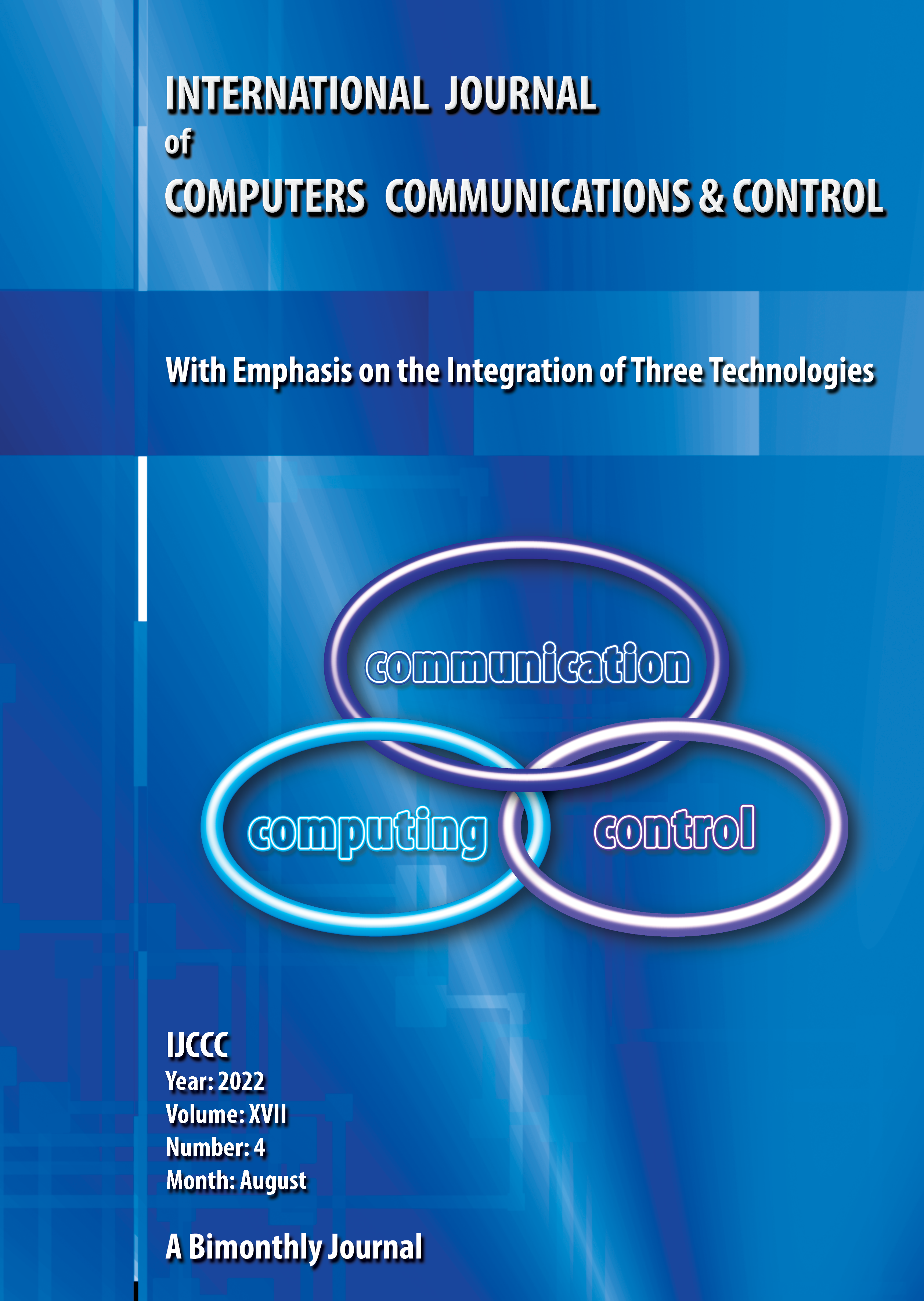A Modified Uncertainty Measure of Z-numbers
DOI:
https://doi.org/10.15837/ijccc.2022.4.4862Abstract
The Z-number is a more adequate construct for describing real-life information. While considering the uncertainty of the information, it also models the partial reliability of the information. It is a combination of probabilistric restriction and possibilistric restriction. In this paper, we modified the uncertainty measurement of the discrete Z-number and proposed the uncertainty measurement of the continuous Z-number. Some numerical examples are used to illustrate the calculation processes and advantages of the proposed method. An application of journey vehicle selection shows the effectiveness of the proposed uncertainty measurement in determining the weights of criteria.
References
Abbaspour Onari, Mohsen, Yousefi, Samuel, and Jahangoshai Rezaee, Mustafa (2021). Risk assessment in discrete production processes considering uncertainty and reliability: Z-number multi-stage fuzzy cognitive map with fuzzy learning algorithm. Artificial Intelligence Review, 54(2), 1349-1383, 2021.
https://doi.org/10.1007/s10462-020-09883-w
Aboutorab, Hamed, Saberi, Morteza, Asadabadi, Mehdi Rajabi, Hussain, Omar, and Chang, Elizabeth (2018). Zbwm: The z-number extension of best worst method and its application for supplier development. Expert Systems with Applications, 107, 115-125, 2018.
https://doi.org/10.1016/j.eswa.2018.04.015
Aliev, RA (2017). Operations on z-numbers with acceptable degree of specificity. Procedia computer science, 120, 9-15, 2017.
https://doi.org/10.1016/j.procs.2017.11.204
Aliev, Rafik A, Alizadeh, Akif V, Huseynov, Oleg H, and Jabbarova, KI (2015). Z-number-based linear programming. International Journal of Intelligent Systems, 30(5), 563-589, 2015.
https://doi.org/10.1002/int.21709
Aliev, Rafik A, Pedrycz, Witold, Guirimov, BG, and Huseynov, Oleg H (2020). Clustering method for production of z-number based if-then rules. Information Sciences, 520, 155-176, 2020.
https://doi.org/10.1016/j.ins.2020.02.002
Aliev, Rafik A, Pedrycz, Witold, and Huseynov, Oleg H (2018). Functions defined on a set of z-numbers. Information Sciences, 423, 353-375, 2018.
https://doi.org/10.1016/j.ins.2017.09.056
Aliev, Rafik A, Pedrycz, Witold, Huseynov, Oleg H, and Eyupoglu, Serife Zihni (2016). Approximate reasoning on a basis of z-number-valued if-then rules. IEEE Transactions on Fuzzy Systems, 25(6), 1589-1600, 2016.
https://doi.org/10.1109/TFUZZ.2016.2612303
Aziz, Aliev Rafig, Akif, Alizadeh, and Rafig, Aliyev Rashad (2015). Arithmetic Of Z-numbers, The: Theory And Applications. World Scientific, 2015.
Banerjee, Romi and Pal, Sankar K (2015). On z-numbers and the machine-mind for natural language comprehension. In Fifty Years of Fuzzy Logic and its Applications, pages 415-457. Springer, 2015.
https://doi.org/10.1007/978-3-319-19683-1_22
Chen, Xiaohong, Lin, Jiong, Li, Xihua, and Ma, Zhiyong (2021). A novel framework for selecting sustainable healthcare waste treatment technologies under z-number environment. Journal of the Operational Research Society, 72(9), 2032-2045, 2021.
https://doi.org/10.1080/01605682.2020.1759382
Dempster, Arthur P (1967). Upper and lower probabilities induced by a multivalued mapping. The annals of mathematical statistics, pages 325-339, 1967.
https://doi.org/10.1214/aoms/1177698950
Jaynes, Edwin T (1957). Information theory and statistical mechanics. Physical review, 106(4), 620, 1957.
https://doi.org/10.1103/PhysRev.106.620
Jiang, Wen, Xie, Chunhe, Zhuang, Miaoyan, Shou, Yehang, and Tang, Yongchuan (2016). Sensor data fusion with z-numbers and its application in fault diagnosis. Sensors, 16(9), 1509, 2016.
https://doi.org/10.3390/s16091509
Kang, Bingyi, Deng, Yong, and Sadiq, Rehan (2018). Total utility of z-number. Applied Intelligence, 48(3), 703-729, 2018.
https://doi.org/10.1007/s10489-017-1001-5
Kang, Bingyi, Wei, Daijun, Li, Ya, and Deng, Yong (2012). A method of converting z-number to classical fuzzy number. Journal of Information & Computational Science, 9(3), 703-709, 2012.
Li, Yangxue, Garg, Harish, and Deng, Yong (2020). A new uncertainty measure of discrete z-numbers. International Journal of Fuzzy Systems, 22(3), 760-776, 2020.
https://doi.org/10.1007/s40815-020-00819-8
Liu, Qing, Cui, Huizi, Tian, Ye, and Kang, Bingyi (2020). On the negation of discrete z-numbers. Information Sciences, 537, 18-29, 2020.
https://doi.org/10.1016/j.ins.2020.05.106
Loeve, Michel (2017). Probability theory. Courier Dover Publications, 2017.
Mazandarani, Mehran and Zhao, Yi (2019). Z-differential equations. IEEE Transactions on Fuzzy Systems, 28(3), 462-473, 2019.
https://doi.org/10.1109/TFUZZ.2019.2908131
Pal, Sankar K, Banerjee, Romi, Dutta, Soumitra, and Sarma, Samar Sen (2013). An insight into the z-number approach to cww. Fundamenta Informaticae, 124(1-2), 197-229, 2013.
https://doi.org/10.3233/FI-2013-831
Pirmuhammadi, S, Allahviranloo, Tofigh, and Keshavarz, M (2017). The parametric form of znumber and its application in z-number initial value problem. International Journal of Intelligent Systems, 32(10), 1030-1061, 2017.
https://doi.org/10.1002/int.21883
Shafer, Glenn et al. (1976). A mathematical theory of evidence, volume 1. Princeton university press Princeton, 1976.
https://doi.org/10.1515/9780691214696
Shen, Kai-Wen, Wang, Jian-Qiang, and Wang, Tie-Li (2019). The arithmetic of multidimensional z-number. Journal of Intelligent & Fuzzy Systems, 36(2), 1647-1661, 2019.
https://doi.org/10.3233/JIFS-18927
Tian, Ye, Liu, Lili, Mi, Xiangjun, and Kang, Bingyi (2020). Zslf: A new soft likelihood function based on z-numbers and its application in expert decision system. IEEE Transactions on Fuzzy Systems, 2020.
https://doi.org/10.1109/TFUZZ.2020.2997328
Tian, Ye, Mi, Xiangjun, Cui, Huizi, Zhang, Pengdan, and Kang, Bingyi (2021). Using z-number to measure the reliability of new information fusion method and its application in pattern recognition. Applied Soft Computing, 111, 107658, 2021.
https://doi.org/10.1016/j.asoc.2021.107658
Valiev, Ahmed A, Abdullayev, Tarlan S, Alizadeh, Akif V, and Adilova, Nigar E (2017). Comparison of measures of specificity of z-numbers. Procedia computer science, 120, 466-472, 2017.
https://doi.org/10.1016/j.procs.2017.11.265
Xian, Sidong, Chai, Jiahui, Li, Tangjin, and Huang, Jie (2021). A ranking model of z-mixturenumbers based on the ideal degree and its application in multi-attribute decision making. Information Sciences, 550, 145-165, 2021.
https://doi.org/10.1016/j.ins.2020.10.038
Zadeh, Lotfi A (2011). A note on z-numbers. Information Sciences, 181(14), 2923-2932, 2011.
https://doi.org/10.1016/j.ins.2011.02.022
Zimmermann, Hans-Jürgen (2011). Fuzzy set theory-and its applications. Springer Science & Business Media, 2011.
Additional Files
Published
Issue
Section
License
Copyright (c) 2022 Francisco Javier Cabrerizo, Yangxue Li, Enrique Herrera-Viedma, Juan Antonio Morente-Molinera

This work is licensed under a Creative Commons Attribution-NonCommercial 4.0 International License.
ONLINE OPEN ACCES: Acces to full text of each article and each issue are allowed for free in respect of Attribution-NonCommercial 4.0 International (CC BY-NC 4.0.
You are free to:
-Share: copy and redistribute the material in any medium or format;
-Adapt: remix, transform, and build upon the material.
The licensor cannot revoke these freedoms as long as you follow the license terms.
DISCLAIMER: The author(s) of each article appearing in International Journal of Computers Communications & Control is/are solely responsible for the content thereof; the publication of an article shall not constitute or be deemed to constitute any representation by the Editors or Agora University Press that the data presented therein are original, correct or sufficient to support the conclusions reached or that the experiment design or methodology is adequate.








